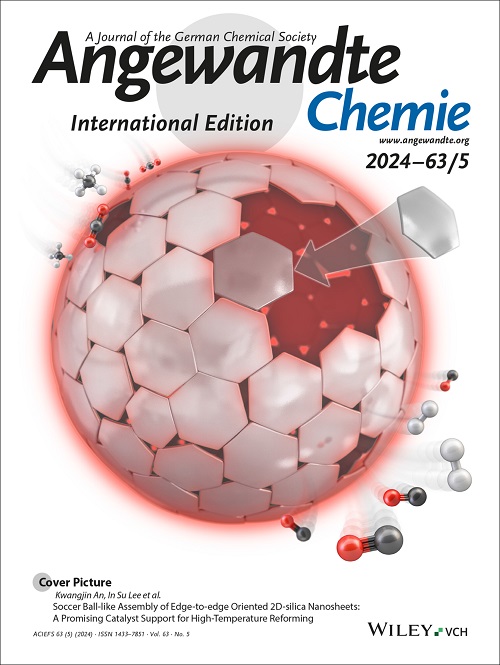Synergistic Light-Ultrasound-Driven Hydrogen Production by Hydrogen Iodide Decomposition Over Dual-Molecular Ferroelectric Heterostructure.
IF 16.9
1区 化学
Q1 CHEMISTRY, MULTIDISCIPLINARY
引用次数: 0
Abstract
Emerging catalytic systems for hydrogen production via solar and mechanical energy conversion often face critical challenges, including band mismatch, interfacial charge recombination, and insufficient charge migration driving forces. To address core issues of low carrier separation efficiency and poor multi-field coupling in molecular ferroelectrics, this study proposes a molecular engineering strategy of dual molecular ferroelectric heterojunctions. We report a facile one-pot solution synthesis of a molecular ferroelectric heterojunction composed of 4,4-difluoropiperidinium lead iodide and 4,4-difluorocyclohexylamine lead iodide ((4,4-DFPD)2PbI4/(4,4-DFCHA)2PbI4), tailored for hydrogen iodide (HI) decomposition under simultaneous light -ultrasonic activation. Under dual-field excitation, the heterojunction achieves a remarkable hydrogen evolution rate of 5.26 mmol g-1 h-1, outperforming its individual constituents ((4,4-DFPD)2PbI4 and (4,4-DFCHA)2PbI4) by factors of 4.5 and 2.4, respectively. Kelvin probe force microscopy (KPFM) confirms efficient charge separation at the heterointerface, facilitated by energy-level alignment and polarization coupling. Both experimental and theoretical investigations attribute the enhanced performance to suppressed charge recombination and the synergistic action of ferroelectric and piezoelectric fields, jointly promoting directional charge migration. This work not only introduces a viable molecular ferroelectric strategy for designing high-efficiency piezo-photocatalytic systems but underscores the critical role of interfacial charge dynamics in catalytic optimization, offering theoretical insights and practical guidelines for next-generation solar-driven catalysts.双分子铁电异质结构上的碘化氢分解协同光超声驱动制氢。
新兴的太阳能和机械能转化制氢催化系统往往面临着严峻的挑战,包括能带不匹配、界面电荷重组和电荷迁移驱动力不足。针对分子铁电体载流子分离效率低、多场耦合差的核心问题,本研究提出了双分子铁电异质结的分子工程策略。我们报道了一种简单的一锅溶液合成由4,4-二氟吡啶碘化铅和4,4-二氟环己胺碘化铅((4,4- dfpd)2PbI4/(4,4- dfcha)2PbI4)组成的铁电分子异质结,专门用于在同时光超声激活下分解碘化氢(HI)。在双场激发下,异质结的析氢速率为5.26 mmol g-1 h-1,分别比其单独成分((4,4- dfpd)2PbI4和(4,4- dfcha)2PbI4)高出4.5和2.4倍。开尔文探针力显微镜(KPFM)证实了在能级对准和极化耦合的促进下,异质界面上有效的电荷分离。实验和理论研究都将这种增强的性能归因于抑制电荷复合以及铁电场和压电场的协同作用,共同促进了定向电荷的迁移。这项工作不仅为设计高效压电光催化系统引入了可行的分子铁电策略,而且强调了界面电荷动力学在催化优化中的关键作用,为下一代太阳能驱动催化剂提供了理论见解和实践指导。
本文章由计算机程序翻译,如有差异,请以英文原文为准。
求助全文
约1分钟内获得全文
求助全文
来源期刊
CiteScore
26.60
自引率
6.60%
发文量
3549
审稿时长
1.5 months
期刊介绍:
Angewandte Chemie, a journal of the German Chemical Society (GDCh), maintains a leading position among scholarly journals in general chemistry with an impressive Impact Factor of 16.6 (2022 Journal Citation Reports, Clarivate, 2023). Published weekly in a reader-friendly format, it features new articles almost every day. Established in 1887, Angewandte Chemie is a prominent chemistry journal, offering a dynamic blend of Review-type articles, Highlights, Communications, and Research Articles on a weekly basis, making it unique in the field.

 求助内容:
求助内容: 应助结果提醒方式:
应助结果提醒方式:


